Hyperledger is an open-source project for blockchain. The Linux Foundation started it in 2015. Since then, it has helped businesses use blockchain in a safe and private way.
It does not have its own cryptocurrency like Bitcoin or Ethereum. Instead, it offers various tools for business needs.
For this reason, many companies choose Hyperledger for better control and privacy. It helps them build private blockchains and share data safely.
Over time, industries such as banking, healthcare, and supply chains have started using it.
Most importantly, Hyperledger keeps growing with fresh ideas and new possibilities. Step by step, it is changing how businesses apply blockchain.
Now, let’s dive deeper into Hyperledger and its place in blockchain technology!
Contents
What is Hyperledger in Blockchain?
Hyperledger is an open-source project that helps you build blockchain systems. It provides a toolkit for creating secure, private blockchains.
Instead of public blockchains, Hyperledger is permissioned, so only trusted people can join. This allows businesses to share information safely.
In short, Hyperledger is designed for companies that need privacy and control.
Why Was Hyperledger Created?
Hyperledger was designed to help businesses use blockchain technology in ways that public blockchains cannot.
Public blockchains like Bitcoin are open to everyone, but they don’t offer the privacy, control, and speed that businesses need.
So, Hyperledger was built to solve these problems.
Here’s why it was created:
- Privacy and Control: Public blockchains show all data to everyone. But with Hyperledger, you can control who sees the data and who joins the network. This is great for businesses that need to keep things private.
- Permissioned Networks: Unlike public blockchains, Hyperledger uses permissioned networks. This means only trusted members can access and participate in the network. It adds more security for businesses.
- Customization: Every business has different needs. Hyperledger gives you the flexibility to create blockchain systems that work best for your specific use case.
- Enterprise Focus: Public blockchains weren’t built for businesses like banks, healthcare, or supply chains. Hyperledger was created to support these industries by providing higher performance, more privacy, and better security.
In short, Hyperledger was created to give businesses a private, secure, and flexible blockchain system. It’s designed to solve the specific challenges businesses face with public blockchains.
How Hyperledge Works: Explained in 8 Steps
Hyperledger is a powerful tool that helps businesses create private blockchain networks. These networks give enterprises control over who can access and share data. It’s built to ensure security, privacy, and smooth operation.
Hyperledger blockchain is used by organizations that need a safe and trusted way to manage their data.
Now, let’s dive deeper into how it actually works.
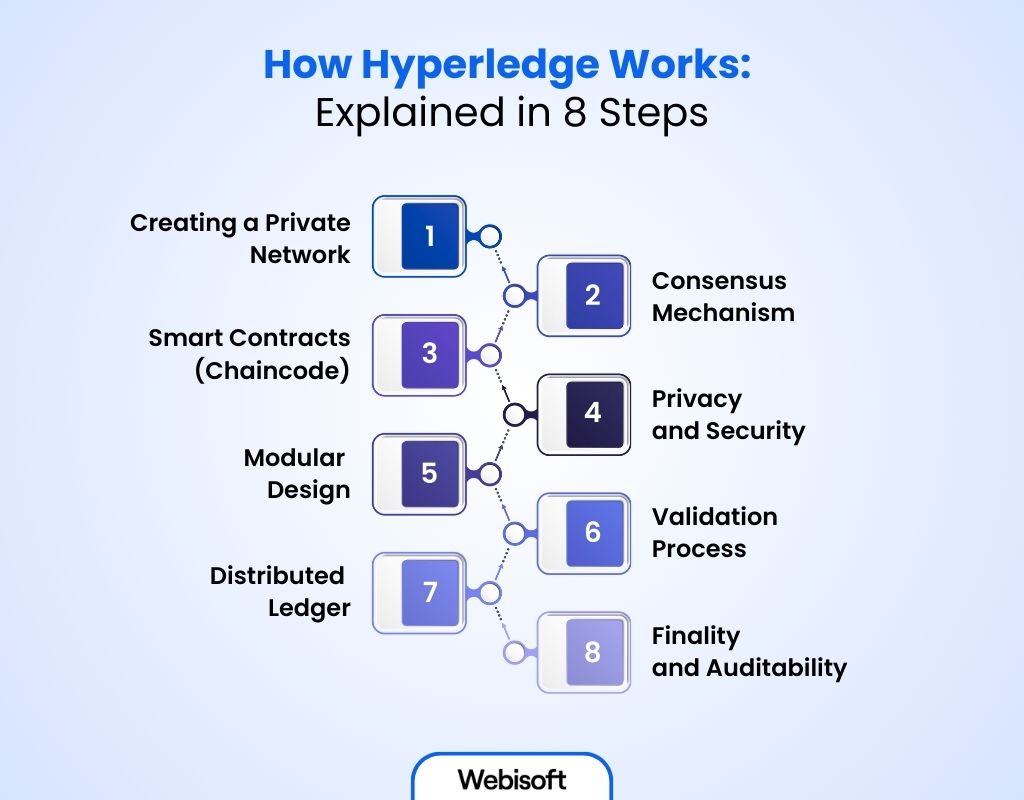
Hyperledger is a powerful tool that helps businesses create private blockchain networks. These networks give businesses control over who can access and share data. It’s built to ensure security, privacy, and smooth operation.
Hyperledger blockchain is used by organizations that need a safe and trusted way to manage their data.
Now, let’s dive deeper into how it actually works.
Step 1: Creating a Private Network
First, you create a private network that is only open to trusted members. Each member has a unique identity, which is controlled by a system called Identity Management. It ensures that everyone is verified and trusted.
Step 2: Consensus Mechanism
Hyperledger uses consensus to ensure all members agree on the data. This helps avoid mistakes or fraud.
There are different consensus methods depending on the network size. For example, Raft is for small networks, while PBFT is better for larger ones.
Step 3: Smart Contracts (Chaincode)
Smart contracts, also called chain codes, are another key part. These are rules written in code that automatically execute when certain conditions are met.
For example, when an item is shipped, a smart contract can trigger a payment automatically. This speeds up processes and reduces human error.
Step 4: Privacy and Security
Privacy is a big part of Hyperledger. It keeps sensitive data safe. One way it does this is through channeling. Channels are private spaces within the network.
Only selected members can see and share information in a channel. This keeps things secure.
Step 5: Modular Design
Hyperledger is modular, meaning businesses can pick and choose the features they need.
For instance, if you need to track products in a supply chain, you can select a special module. You can also add more features like encryption or access control to match your needs.
Step 6: Validation Process
After a transaction, it needs to be validated. This means the network checks if the transaction follows the rules.
Once validated, the data is added to the blockchain.
Hyperledger uses different validation methods, depending on the consensus style you choose.
Step 7: Distributed Ledger
Once the transaction is approved, it’s added to a shared record called a distributed ledger. This ledger is not stored in one place. Instead, you and every trusted member of the network get the same exact copy.
Because everyone has access to the same version, no one can secretly change or delete anything. It keeps the data safe and honest. This shared system builds trust and makes sure no one has more control than others.
Step 8: Finality and Auditability
Finally, after a transaction is added to the ledger, it is final. This means it cannot be changed. Because everything is recorded on the ledger, it’s easy to track and audit transactions.
Hyperledger helps businesses stay transparent and compliant with regulations.
Key Hyperledger Projects
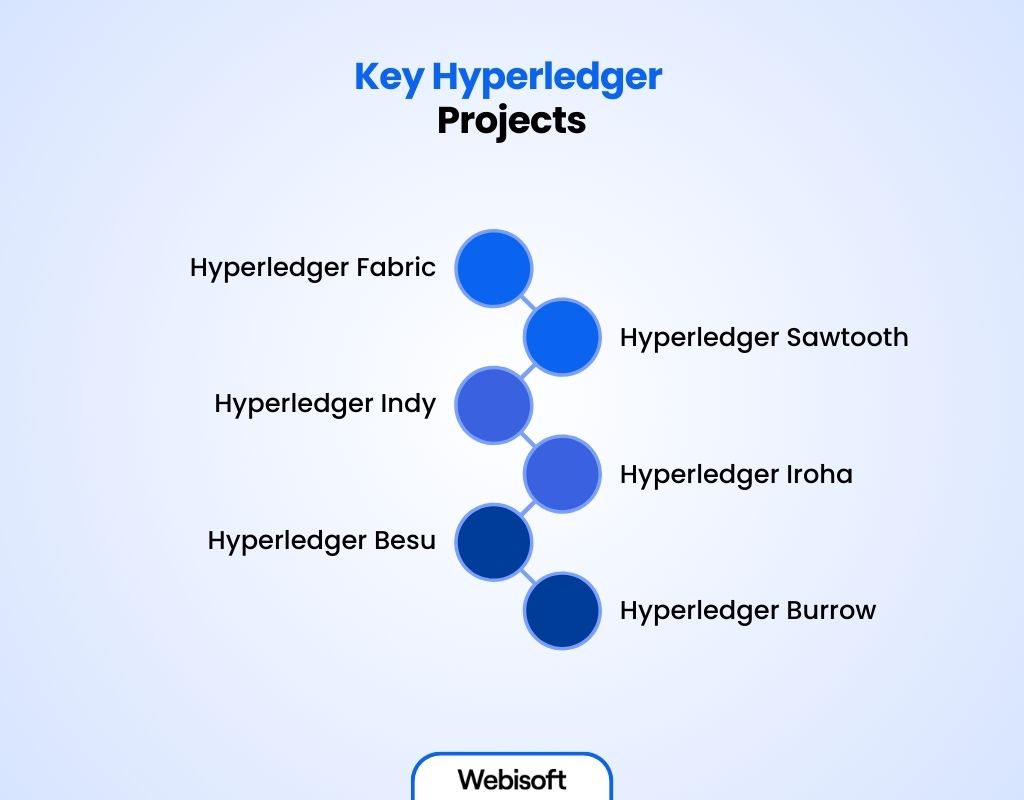
Hyperledger includes several powerful projects, each designed to meet different business needs. These projects are flexible, secure, and built to solve specific problems.
Each project has unique features that make it a good choice for various industries. Let’s explore the key projects in more detail and see how they work.
Hyperledger Fabric
Hyperledger Fabric is one of the most widely used projects. It’s a modular blockchain framework. This means businesses can build custom networks based on their needs.
Fabric is flexible and used in industries like finance, supply chain, and healthcare. It allows for private data sharing through channels and automates processes with smart contracts.
Hyperledger Sawtooth
Sawtooth is designed for large-scale networks. It’s highly scalable and works well for businesses that need a flexible solution.
Sawtooth uses Proof of Elapsed Time (PoET), a unique consensus method. This makes it faster and more energy-efficient than other methods.
Sawtooth is great for IoT and supply chain applications.
Hyperledger Indy
Indy focuses on digital identity management. It helps businesses create secure, decentralized identity systems.
With Indy, users control their identity and data, giving them more privacy and security.
Indy is used in areas like online authentication and digital certificates , alongside Hyperledger tools and projects.
Hyperledger Iroha
Hyperledger Iroha is simple and easy to use. It’s designed for businesses that need an efficient, lightweight solution. Iroha is ideal for financial services and IoT applications.
It’s also easy to integrate because it has readable APIs, making it a good choice for companies that need fast implementation.
Hyperledger Besu
Besu is an Ethereum-compatible blockchain that works in both private and public networks. It’s designed for enterprise-level use, offering high scalability.
Besu supports smart contracts and is ideal for industries like asset management and finance. It balances privacy and public transparency.
Hyperledger Burrow
Burrow is a blockchain that features permissioned smart contracts. It focuses on fast and secure transactions.
Burrow is great for creating applications where automated rules are needed, like finance.
It also supports Ethereum-based smart contracts, making it a powerful tool for businesses that need secure automation.
How Hyperledger Differs from Other Blockchains
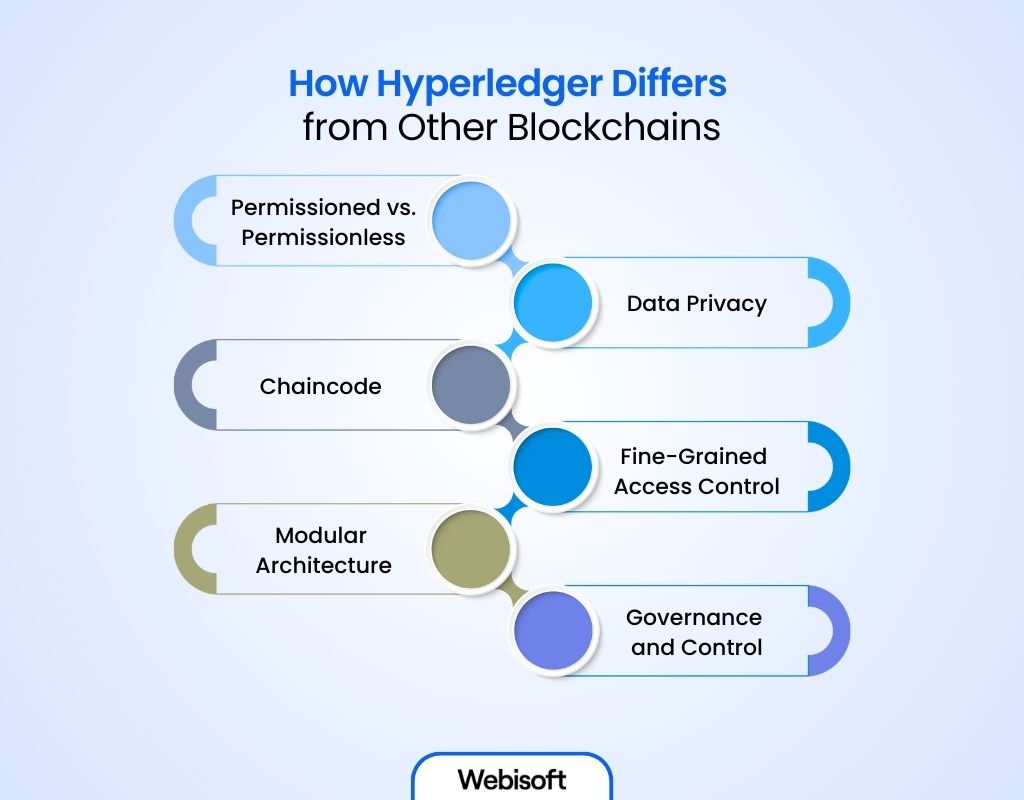
Hyperledger isn’t like Bitcoin or Ethereum. It’s built for businesses that need privacy, control, and strong security.
While public blockchains work well for open systems, Hyperledger is better for organizations that want a trusted and private environment.
Let’s walk through the key differences.
Permissioned vs. Permissionless Networks
Hyperledger uses a permissioned network. This means only approved members can join and take part. A central group controls who gets access.
Public blockchains like Bitcoin and Ethereum work the opposite way. Anyone can join, see the data, and interact. That open setup can create security issues for businesses that need to keep things private.
Data Privacy
In public blockchains, everything is out in the open. Everyone can see every transaction.
That’s not ideal if your business handles sensitive data. Hyperledger fixes this by offering private channels. Think of these as small private chat rooms where only selected members can see and work on transactions.
For example, in a supply chain, only the supplier, factory, and distributor would have access to their specific deals. No one else can peek in.
Chaincode (Smart Contracts)
Hyperledger doesn’t use the typical smart contracts you find on Ethereum. It has something called chaincode. It does the same job but is more flexible.
You can write chaincode in Go, Java, or JavaScript. This makes it easy to connect with systems your business already uses. In contrast, Ethereum relies on Solidity, a language that’s harder to adapt for most companies.
Fine-Grained Access Control
Hyperledger lets you set rules for who can do what. You can decide which employee sees what data or who can approve a transaction.
Public blockchains don’t offer that level of control. Once you’re on the network, you can see everything. That’s fine for open communities, but not great for business needs.
Modular Architecture
Hyperledger is modular, which means you can pick and use only the parts you need.
For instance, if you’re building a supply chain platform, you might use Hyperledger Fabric. It’s built exactly for that. This plug-and-play model saves time and money.
Public blockchains are more rigid. You don’t get to customize much. They follow a one-size-fits-all design.
Governance and Control
With Hyperledger, you decide how the network works. You choose who joins, how rules are made, and how issues are solved.
On public blockchains, decisions are made by the community or miners. That’s great for open networks but not ideal for companies that need structure and control.
Use Cases of Hyperledger
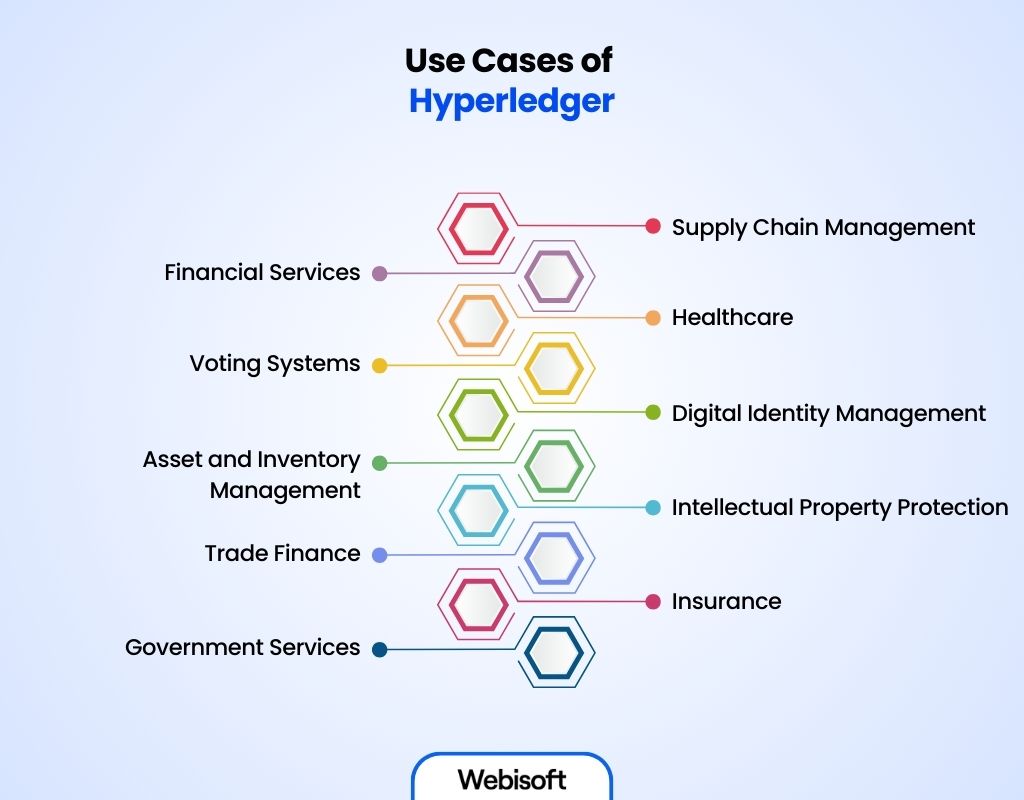
Whether you’re in finance, healthcare, logistics, or government, Hyperledger can help you track, share, and manage information more efficiently.
Here’s how different sectors use Hyperledger in real-world situations:
Supply Chain Management
In supply chains, Hyperledger tracks products from start to finish. It helps businesses follow goods from factories to stores.
This makes sure products are safe and meet quality standards. Hyperledger uses private channels to protect sensitive data.
Financial Services
Hyperledger helps banks and financial services make transactions faster. It allows money to be sent across borders quickly and safely.
This reduces costs by cutting out extra steps. Hyperledger also keeps financial data secure.
Healthcare
In healthcare, Hyperledger keeps patient information safe. Doctors and hospitals can share medical records securely.
Only trusted users can see this data, ensuring privacy. This reduces the chance of unauthorized access.
Voting Systems
Hyperledger makes voting systems more secure. It ensures that once votes are cast, they cannot be changed. This helps elections stay fair.
Hyperledger makes voting more trustworthy and transparent.
Digital Identity Management
Hyperledger helps manage digital identities. It keeps personal data secure. Hyperledger Indy allows people to control who sees their information.
Asset and Inventory Management
Hyperledger tracks assets and products. Businesses can follow inventory from warehouses to stores. This makes managing products faster and more accurate.
It helps reduce mistakes and improves efficiency.
Intellectual Property Protection
Hyperledger is used to protect intellectual property. It tracks the ownership of inventions or ideas.
This makes it harder for others to steal someone’s work. Hyperledger keeps ownership records safe and secure.
Trade Finance
In trade finance, Hyperledger speeds up processes. It tracks important documents like letters of credit.
These documents are essential for international trade. Hyperledger makes these transactions more reliable and faster.
Insurance
In the insurance industry, Hyperledger makes claims processing quicker. It helps track policies and claims accurately.
Hyperledger reduces errors and fraud, helping companies serve customers better.
Government Services
Governments use Hyperledger to manage services better. For example, it stores land records securely. This helps prevent data changes.
It is also used to track payments, ensuring they go to the right people.
Future of Hyperledger
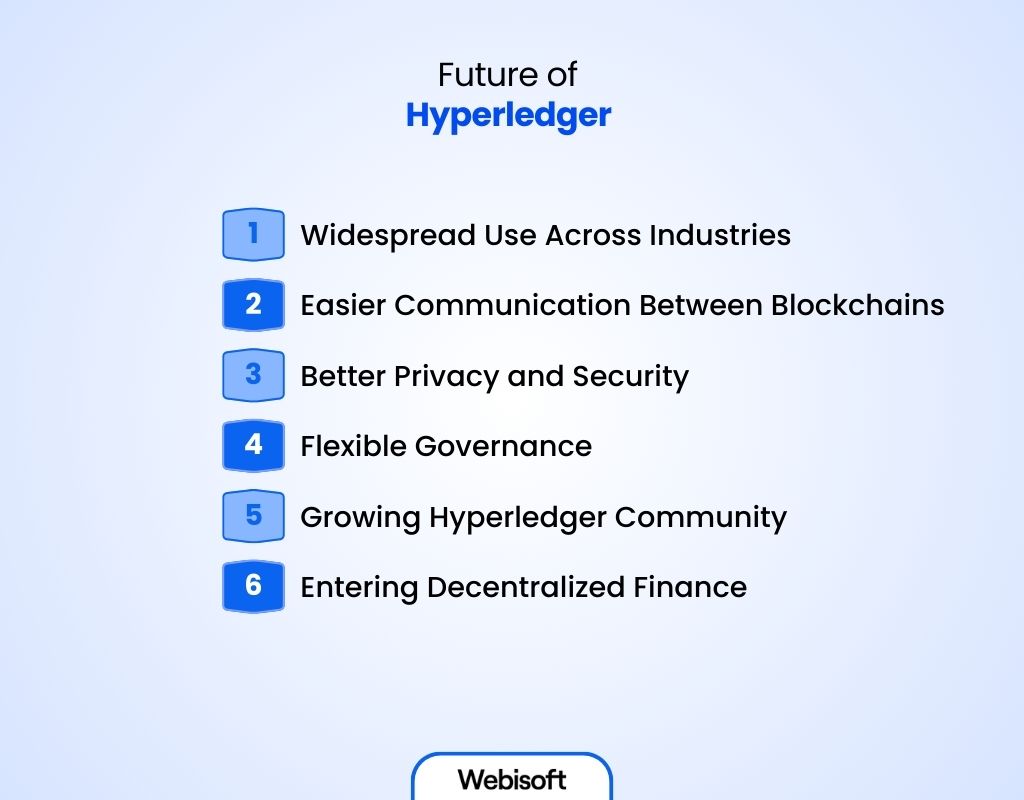
The future of Hyperledger looks very bright. More businesses are looking for safe, fast, and flexible solutions.
Hyperledger is ready to meet these needs and become a key player in the blockchain world. Here’s how Hyperledger is shaping its future:
Widespread Use Across Industries
As more companies see the benefits, Hyperledger will be used in many more industries. Supply chains, banking, healthcare, and government services will adopt it. Hyperledger’s flexible design lets businesses pick what they need.
Easier Communication Between Blockchains
Right now, different blockchains don’t always work together well. Hyperledger is solving this. It will help blockchains talk to each other. This means businesses can move data and assets safely between networks.
Better Privacy and Security
Privacy is always important for businesses. Hyperledger will improve its security. Only trusted people will be able to access sensitive data. Hyperledger will use new methods to protect business data.
Flexible Governance
Hyperledger gives businesses control over how things are managed. As it grows, companies will be able to set rules about who can join the network. This will make it easier for businesses to use Hyperledger with fewer issues.
Growing Hyperledger Community
As more people join the Hyperledger community, the system will keep improving. More tools and apps will be created. This growth will make Hyperledger more powerful and easier to use.
Entering Decentralized Finance (DeFi)
Hyperledger could also play a role in DeFi (Decentralized Finance). It will provide secure environments for digital money transactions and smart contracts. This will help businesses in the growing DeFi space.
Conclusion
Now you should have a clear idea of what Hyperledger is and how it works in blockchain. It’s not just another blockchain platform. It’s built for businesses that need privacy, control, and reliable performance.
Unlike public blockchains, Hyperledger gives you the tools to build secure and flexible networks. That’s why industries like supply chain, finance, and healthcare are already using it to solve real problems.
As more companies move toward blockchain, Hyperledger will continue to grow. It’s helping shape the future of how digital systems work—faster, safer, and smarter.
FAQs
Is Hyperledger a cryptocurrency?
No, Hyperledger is not a cryptocurrency. But here’s something exciting—it helps build blockchain apps! Unlike Bitcoin or Ethereum, it doesn’t have coins. Instead, it gives businesses the tools to create secure and smart blockchain solutions for real-world problems.
Who uses Hyperledger?
Big industries love Hyperledger! Banks use it for secure transactions. Hospitals trust it for patient records. Supply chains rely on it for tracking goods. Most importantly, it makes everything faster, safer, and smarter. That’s why so many businesses use it.
Why should businesses use Hyperledger?
Businesses need privacy, and Hyperledger gives them that! It keeps data safe, while also being flexible. Most importantly, it builds trust. With Hyperledger, companies can create secure blockchain apps, making their work faster and more reliable.
